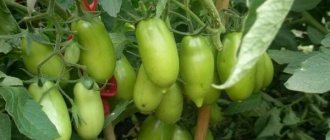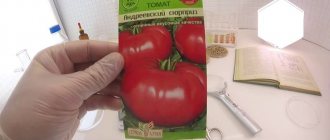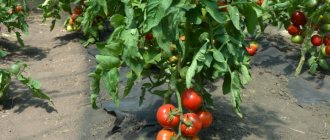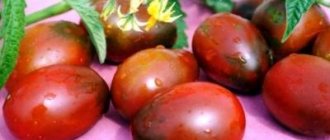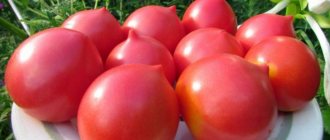What do bushes and fruits look like?
The botanical description of the variety is mid-early, since after planting the seedlings in the ground, 100–105 days pass before the tomatoes are harvested. The characteristics of the bushes are indeterminate, that is, their stems can grow unlimitedly after setting tomatoes, so they need to be tied up and pinched, and also standard. The physical characteristics of the variety are bushes 1.6 - 1.8 m in height, in the south of Russia they can grow up to 2 m. Large dark green leaves grow on the bushes.
The tomato is heart-shaped and pink in color. According to the description, the first fruits, like other types of Ox heart, have a mass of 400 - 450 g, and the next pink fruits when ripened are much smaller - 250 - 300 g.
The tomato contains 5 - 6% dry matter, the fruit itself is fleshy, has medium density, very sweet, and does not crack.
The beneficial properties of the fruits are that they contain vitamins B1, B6, C (strengthens the immune system), since they contain more sugar than red vegetables, they can be eaten even by those who have diseases of the stomach and intestines.
See also
Characteristics of the Solerosso tomato variety, its yieldRead
Growing and care
The bushes have weak side shoots and are tall, so they need supports and a garter. To increase the yield, plants need to be shaped.
Water the tomatoes regularly, but in moderation. Young bushes are watered more often.
Attention! If the leaves begin to curl, it means the plant does not have enough moisture.
The first fertilizing is added to the soil three weeks after the seedlings are transferred to the garden. Ingredients: potassium chloride 10 g, superphosphate 50 g. The second time, fertilizers are applied during the formation of the first ovaries: potassium nitrate 20 g and liquid superphosphate 80 g. The bushes are fertilized with the same composition during the period of fruit ripening (two feedings).
Don’t forget to weed the weeds around the seedlings.
Advantages and disadvantages of the variety
Description of benefits:
- The variety is resistant to brown leaf spot, tobacco mosaic virus, and macrosporiosis;
- The fruits are sweet and fleshy.
Flaws:
- not very large harvests;
- the bushes are very capricious and require careful care;
- vegetables do not last long and deteriorate during transportation, which is why they are not suitable for industrial cultivation;
- The branches are weak and can bend under the weight of the fruit.
Useful video
| Mid-early | Mid-season | Super early |
| Torbay | Banana legs | Alpha |
| Golden King | Striped chocolate | Pink Impression |
| King London | Marshmallows in chocolate | Golden stream |
| Pink Bush | Rosemary | The Lazy Man's Miracle |
| Flamingo | Gina TST | Pickling miracle |
| Mystery of nature | Ox heart | Sanka |
| New Koenigsberg | Roma | Locomotive |
If you find an error, please select a piece of text and press Ctrl+Enter.
How to plant
Seeds are sown in boxes in March. The soil should be compacted slightly before planting. After scattering on the soil, the seeds are sprinkled with a 1 cm layer of chernozem and peat, then watered with warm water and covered with film. The boxes are placed in a room with an air temperature of +25°C.
When you see the first shoots, remove the film and expose the seedlings to the light. The first week the temperature should be +15 – 16 °C, and later it can be 20 – 25 °C. They dive, that is, seedlings are planted when 2 true leaves grow.
Growing and care
Planting seedlings has its own characteristics. In the southern regions of Russia it is better to plant seedlings in open ground; in the Central region they are planted under film. In the north they are placed exclusively in heated greenhouses.
It is worth sowing seedlings in March. The soil in the containers is compacted, the seeds are laid out and lightly sprinkled with a fertile mixture. It is necessary to water only with warm water. Can be covered with film for faster germination.
Seedlings must be kept at a temperature not lower than 25. When the first shoots appear, it is important to provide good lighting and reduce the air temperature. It is also necessary to monitor soil moisture.
Important to remember! You cannot bury a tomato seed more than 2.5 cm. The sprout may simply not sprout.
Picking is carried out if there are 2 sheets.
The time period from sowing to planting seedlings in open ground varies from 55 to 60 days. It is desirable that the sprout have 6-7 leaves and one inflorescence. The variety is characterized by good fruit set and smooth ripening. If you plan to plant in open ground, then this must be done before May 25, provided that the air temperature is above 15 degrees. It is very important to maintain a distance between the bushes; it should be 30-50 cm to ensure free access of air to the plants.
You may be interested in:
The “Pink Heart” sprout, as a tall one, is planted in the ground about 2/3 of the trunk. They don’t go deep
It is very important to follow the watering regime for tomatoes. In the first time after planting, excessive moisture will not allow the root system and stem to develop properly. In addition, the crop is very susceptible to fungal diseases, which is facilitated by excessive waterlogging.
Care consists of maintaining soil fertility, i.e. periodically feeding with organic and mineral fertilizers.
Plant staking is important. This will provide access to sunlight and air to the plants, which in turn will get rid of rot and late blight. This measure is especially relevant in rainy summers.
Tomatoes do not like temperature changes. Both at low and too high temperatures, the plant receives severe stress and stops growing and fruiting.
The variety is suitable for cultivation in all parts of our country. In the northern regions it is better to do this in heated greenhouses, but in the south it will grow in open ground. In temperate latitudes it is worth using a film shelter.
The period for planting seedlings of this variety is 60 days from the date of sowing the seed material. Purchased seeds are checked for spoilage before planting.
Tomato seeds are sown in prepared boxes with soil at the beginning of March. The soil composition includes chernozem and peat. The seed material is deepened by 0.5 cm, sprinkled with earth and carefully watered. Covering the containers with film, they are moved to a warm, bright place (temperature 25).
Advice! To speed up the germination process, it is better to pre-soak the seeds.
The film is removed after germination. The first week the air temperature should be 14-15 degrees, gradually increase it to 23 degrees.
The seedlings are transplanted into individual pots after the plant has three leaves.
Pruning is carried out when the seedlings have grown to 4-5 cm. They are formed into 2 shoots. Removing stepchildren allows the bushes to be planted more densely.
A week before transplanting, the seedlings are hardened off. They are taken out into the fresh air for several hours a day. A couple of days before planting, the three lower leaves of young bushes are cut off; this will protect the tomatoes from diseases.
Two months after sowing the seeds, the seedlings are transferred to a greenhouse or open soil. By this time, young plants already have 8-10 leaves and one inflorescence. A tall plant is planted in a hole, the depth is at least 20 cm. Ash (1 l), humus (1 l) and superphosphate (15 g) are placed in the hole. The seedlings are planted 50 cm apart. 3 bushes are planted per square meter. The holes are covered with mulch.
This variety of tomatoes is intended for growing in greenhouse conditions. It does not tolerate cold and windy weather well. In the southern regions of the country, tomatoes will ripen easily in open ground. In Central Russia, bushes are grown under film. In the northern regions, tomatoes grow safely only in greenhouses.
When transporting tomatoes, they have to be wrapped in wrapping paper, since any shock leads to dents appearing on their sides. Injured tomatoes quickly deteriorate; their shelf life is only one or two days. Fruits picked at technical ripeness are ripened at room temperature for three to four days, and then can be stored in the refrigerator for up to a week.
The variety is grown only through seedlings.
Tomato can be cultivated in open ground and under temporary film covers. The age of seedlings at the time of transplantation is 55-60 days. The plants are grown in two stems, carefully pinched and secured in an upright position.
Seeds are sown in March on lightly compacted soil and covered with a layer of peat. The box is placed in a place with a temperature of 25 degrees. When the seedling loops appear, the seedlings are moved to a cool place for 7-8 days (15-16 degrees), then transferred again to a warm place.
The optimal temperature for growing seedlings is 20-22 degrees.
When two true leaves develop, the seedlings are transferred to separate cups.
Seedlings ready for transplanting into open ground should have 6-7 true leaves and one flower cluster.
Caring for plants consists of maintaining the soil in a moist, loose state. During the growing season, you need to fertilize twice with mullein infusion: in the phases of mass flowering and mass filling of fruits.
Medium early/Tall
User rating: 5/5
Early maturing / Tall
User rating: 5/5
Mid-season / Tall
Nuances of agricultural technology
Plant seedlings in open ground or a greenhouse after 60 - 65 days. The seedlings should already have 6–7 true leaves and one flower cluster. Select soil that is fertile, light, and rich in nutrients. Feed the bushes with organic and mineral fertilizers approximately every 2 weeks.
See also
Correct timing of sowing tomatoes for seedlings in the UralsRead
In addition, water them, remove shoots in a timely manner and pull out weeds. Spray the bushes with special preparations to protect against harmful insects and diseases.
The bushes are very tall, so tie them up. Place supports under the branches to prevent the plants from breaking under the weight of the pink fruits. It is best to leave 1 or 2 stems when forming, and remove the remaining stepsons.
Reviews
The Pink Heart variety is preferred by gardeners who grow tomatoes for themselves. This is quite justified, because the crop cannot boast of high yields. What reviews do those who have already tried it leave about the variety?
Maria, Vyazniki: “ I have been growing Pink Heart tomatoes for several years in a row in a greenhouse and am very pleased. From one bush I collect up to two kilograms of large fruits. The taste is unforgettable, the flesh is sweet, fleshy, without sourness. We eat it fresh, I haven’t tried adding salt.”
Ekaterina, Rovenki: “I grow tomatoes in open ground, despite the fact that the variety is more suitable for greenhouses. The fruits always grow large and fleshy. Their flesh is juicy, but not watery. Fresh tomatoes are very tasty. I tried to cover it in pieces for the winter, it turned out well.”
Ivan, Balakhna: “Last year I decided to plant a Pink Heart in the greenhouse. Everyone in our family loves these tomatoes, but they are difficult to find in the market. I followed all the rules of growing, watering and fertilizing, and as a result I got a good harvest.”
Diseases and pests
Tomatoes have good immunity to fungal diseases. But brown rot may appear on tomatoes. It is necessary to eliminate diseased fruits and stop adding nitrogen, and spray the bushes with the preparation “Hom”.
Reviews say that melon aphids and cutworms may appear on tomatoes. In this case, the bushes are sprayed with the preparation “Bison”. The drug “Strela” also helps against cutworms.
If the bushes are attacked by slugs, then you need to cut off the tops and scatter the ash on the ground.
This tomato variety produces large, pink-colored fruits and is quite demanding when it comes to watering and fertilizing, so it is best grown by experienced gardeners.
Tomatoes Pink heart on video
If you have grown Pink Heart tomatoes, please write whether you liked them or not. What was the yield and taste of the fruits like under your climatic conditions? How do you assess a variety's resistance to disease? Briefly describe the advantages and disadvantages of this tomato in your opinion. If possible, attach to your review a photo of the entire bush as a whole or individual fruits you grew. Thank you!
Your reviews of the Pink Heart tomato and additions to the description will help many gardeners evaluate this variety objectively and decide whether it is worth planting or not.
This is a natural variety of tomato. Therefore, we recommend taking seeds from a ripe fruit and using them for planting in subsequent seasons.
Characteristics of the variety
When compiling the characteristics and description of the variety (point by point), breeders do not indicate the height of the plant, however, reviews from those who have already planted, grown and enjoyed the fruits indicate that the plant:
- indeterminate, powerful, but not very tall;
- salad purposes;
- the fruits are large and weighty;
- the consistency of the pulp is tender, granular, soft, fleshy, with a light aroma;
Advantages
- high yield
- the balance of organic acids and sugars is well maintained;
- The taste of the tomato is well expressed, rich, the fruit has a pleasant aftertaste.
- a lot of fruits are set;
- fruit setting in all weather conditions.
Flaws
- the fruits of the next cluster are smaller, and so it continues until the last one - gradual, smaller;
- in short summer conditions, not all of them ripen and they have to be harvested brown or green.
Fetal characteristics
The skin of tomatoes is quite dense, which allows them to be protected from adverse weather conditions. The fruits picked from the bush ripen and have the opportunity to lie for some time without losing their organoleptic properties.
Instructions for using the variety indicate that the variety is quite suitable for processing into tomato products. Indeed, tomatoes are meaty and have a wonderful, sweaty texture, as well as a rich, red color. This allows you to get juice, sauce, and even tomato paste by slightly boiling them.
Reviews about the variety say that “Loving Heart Red”, in unfavorable summer conditions, showed the best yield of all the tomatoes planted.
Interesting fact!
As for the shape, the producer of the variety describes it as heart-shaped, but those who have already planted it say that all the fruits are of different shapes. In this case, one bush bears fruits from round-oval-heart-shaped to heart-shaped.
Our catalog of tomato varieties and their descriptions with photos
Tomato “Bull's heart pink”: description of the variety, photos and reviews
general information
There is no such person who would not love pink tomatoes: they have an unsurpassed taste.
Unlike ordinary tomatoes, they are much sweeter, have a thin skin, and therefore do not affect the gastric mucosa. The Pink Heart tomato says it all: pink in the shape of a heart. This is what we will talk about.
- It belongs to an indeterminate, tall species (reaches two meters).
- For growing in greenhouses.
- Medium early ripening (100–110 days).
- Productivity up to three kg per bush.
- Purpose: fresh consumption.
- The fruits are set up to 100%.
- Requires bush formation.
- Simple inflorescences.
- The fruits are heart-shaped, pink, rich in color, slightly ribbed, weighing from 200 to 400 g.
- The fruit is large, dense inside, 4–5 lobed.
- When ripe, the fruits do not crack.
- Excellent taste, increased sugar content.
- Resistant to viral diseases.
- They can't stand transportation.
- Not subject to long-term storage.
Let's take a detailed look at the advantages and disadvantages of the Pink Heart tomato from the description of the variety.
This variety has a medium-early ripening period, which is 110 days or more from seed germination, but, according to reviews from gardeners who grow “pink heart”, the harvest appears on 120–135 days.
Correctly calculate the time for sowing seeds. This is done like this: from the day of planting (May 10–15) the seedlings in the greenhouse, we subtract 60–65 days (the age of the seedlings), and we get the first days of March. We take another 5 days for seed germination, so it turns out that we sow on February 25th.
The yield of this variety is low, so farmers do not favor it and it is almost impossible to buy it on the market. The “Pink Heart” tomato is grown by true lovers of taste and appearance. The variety is quite young, but those who have tried it claim that they get a maximum of 10 kg per square meter, but for this you need to try hard.
And another reason why professionals do not like this variety is that “pink heart” deteriorates during transportation, as it has a delicate thin skin. And, of course, these tomatoes cannot be stored for a long time.
Tomatoes are tasty, the flesh is sugary and meaty, and excellent fresh. A salad made from such fruits does not produce juice; the skin is soft and invisible, which is undoubtedly a big plus. For those who have high stomach acidity, this variety is irreplaceable.
Tomatoes are suitable for making sauces and seasonings; they can be prepared in salads.
To get a harvest, you need to form a bush.
Tall bushes form one or two stems. The easiest thing is one stem: remove all the stepsons. This method will allow you to plant plants more often. You can use the “containment method”: leave the stepson above the first inflorescence, wait until it forms two flower clusters and pinch it off. Others should be deleted. What does this give?
- The growth of the bush will be restrained;
- The yield will increase by 30%, since the largest fruits are formed on the lower clusters.
Recommended cultivation in two trunks: pros and cons? For tall varieties, it is advised to leave one stepson and grow it as the main stem.
Pros:
- Restraining upward growth
- Increase in yield,
- Fewer seedlings needed.
Minuses:
- Greater distance between bushes.
- The load on the bush increases, requiring additional feeding.
- The fruits will eventually be born smaller.
Is it worth recklessly chasing an imaginary harvest? Conclusion: better than one, but strong trunk.
- Excellent taste and appearance are the main advantage;
- Disease resistance;
- Harmonious ripening of the crop;
- High fruit set.
And what should be considered the main disadvantage of the “Pink Heart” tomato according to reviews and photos? Productivity!
It is low for such care, so you should not give this variety priority in the greenhouse; you can grow it for your soul and assortment.
Since the tomato is tall, you need to approach the cultivation of seedlings thoroughly, following certain techniques.
Sowing seeds
It was said above about the timing of sowing seeds. There is nothing unusual here: the seeds are soaked in a “Fitosporin” solution, which stimulates germination and also protects against diseases.
Sow in prepared light soil, do not deepen. Make a groove 1 cm deep, pour it with a warm solution of potassium permanganate and place the seeds at a distance of 2 cm from each other.
Sprinkle with soil and, covered with film, place in a warm place with a temperature of at least 26 degrees.
As soon as the shoots appear, open the container and within 7 days reduce the temperature to 15 degrees, then raise it again to 22.
Picking
In the phase of two true leaves, a pick is made. The soil is prepared from peat, humus and sand in equal parts, adding double superphosphate to it according to the recommended scheme.
Dive into small peat cups. As they grow, plant them in larger pots, covering the trunk. This way, by shortening the stem, you will give the root system the opportunity to develop.
Seedling
If, during the next transplantation, leaves fall into a large container, they need to be cut off. Experienced hobbyists have their own techniques to avoid replanting several times; they increase the height of the container. Such a “growing” pot will be a thick bag made of black film, with the edges curved downwards outwards, which is straightened upward as the seedlings grow.
Any cuttings from seedlings should be done with a tool treated in potassium permanganate or an alcohol solution.
Do not be afraid to bury the seedlings, since the first flower cluster is formed in this variety above the eleventh leaf.
READ MORE: Sun-dried tomatoes in the oven at home, recipe with photos
After each transplant, plants must be sprayed with a solution of your choice to protect them from pests.
Do not allow the seedlings to stretch out. To do this, observe the temperature and light conditions. The illumination should be 16 hours, no less, and the temperature during the day should be 20, in the dark at night – about 10 degrees.
Transplantation into the ground
We plant 60–65-day-old seedlings in the ground at the stage of 6–8 true leaves. But since we are planting it in a greenhouse, and this is not a room, there are different conditions, it will be a huge stress for the seedlings. What to do?
Two weeks before transplanting, it is necessary to accustom the plants to changes: harden it, open windows, reduce night temperatures. If possible, take tomatoes into the greenhouse during the day. Good seedlings have a purple tint under the leaves. And two days before planting, it is necessary to cut off the lower three leaves, thereby providing protection from diseases, ventilation and accelerating the appearance of the flower cluster.
Prepare the greenhouse for planting: treat it with sulfur two weeks in advance; its smoke best kills pests and diseases.
For tall varieties, holes are prepared accordingly:
- The depth of the hole must be at least 20 cm;
- Add 1 liter of ash, 15 g of superphosphate, 1 liter of humus to the bottom.
Seedlings that have been well watered in advance are planted. Be sure to mulch the top of the hole; mulch ensures proper air exchange for the root system:
- The ground beneath it does not become crusty,
- After watering, there is no need to loosen the soil,
- In hot weather, the roots of the plant do not overheat,
- Moisture does not evaporate quickly.
Planting scheme: Planted in a checkerboard pattern at a distance of 50–60 cm from each other.
Different periods of tomato development require different amounts of water.
So, young seedlings should be watered often, but very moderately. Mature plants require abundant but infrequent watering.
Plants in greenhouses get sick not from cold weather and frosts, but most often from high humidity. Therefore, you should not be overzealous with watering. To understand when plants are thirsty, look at the tops of the bushes: if the leaves curl, it's time to water!
When planting seedlings in a hole, water it generously with five liters of warm water, the second watering - no earlier than 10 days later.
It is better to water the plants using the method common among amateurs: through a bottle, buried with the open neck to the very root, through the cut off bottom. This will provide water to the root system gradually, and you will know the volume of water poured.
It is better to water during the daytime so that the humidity in the greenhouse decreases until the evening.
Top dressing
Fertilizing is carried out throughout the growing season. You can use ready-made solutions such as “Ideal” or “Fertility” once every 10–12 days, following the instructions. Phytophthora is required to be treated with “Healer” at least once every two weeks.
To increase the number of ovaries and protect against diseases, make your own solution. It is safer and the effect is wonderful. Repeat this feeding once every 10 days until fruits are completely set on all flower clusters.
For the solution we take:
- Boric acid 1 g;
- Potassium permanganate several crystals for a bright pink color;
- Iodine 60 drops;
- Urea 1 tbsp. spoon;
- Milk 200 ml
Dilute the ingredients in 10 liters of water and spray the plants.
Diseases and pests
By following the recommendations given above, the plants will not get sick, and they are not afraid of pests.
Let's repeat the rules:
- Spray the seedlings with the “healer” preparation;
- Disarm the greenhouse and tools;
- Observe the regime of watering and ventilation of the greenhouse;
- Do not thicken the plantings, remove leaves from below;
- Use mulch;
- For prevention, treat plants with drugs once every 10 days.
- Feed on time, as healthy bushes do not get sick.
Taking into account the experience of gardeners, you can get a harvest of tasty and beautiful “Pink Heart” tomato.
I wish you excellent harvests and joy from new varieties!
Tomato Pink Heart is one of the subspecies of Ox Heart. But its difference is in the pink fruits. “Pink Heart” was released in Russia in 2002. The variety was included in the State Register of Breeding Achievements in 2003. Originator of the variety: agrofirm Poisk.
It’s not for nothing that vegetables from your own garden plot seem both tastier and more beautiful. Grown with care and love with our own hands, they delight us throughout the harvest season as fresh salads. And during the long winter they appear on tables in the form of pickles, sauces and various homemade canned dishes. There are few gardeners who can do without tomatoes on their plot. This article will focus on the Pink Heart tomato variety.
Description of the variety
The “Pink Heart” tomato is one of the subspecies of the famous and popular “Bull’s Heart” variety. The second got its name due to the large size of the fruit. “Pink Heart” has the same feature. The external difference of this subspecies of large tomatoes is the soft pink color of the tomatoes themselves.
The variety “Pink Heart” was selectively bred in Russia in 2002. In 2003, it was officially entered into the State Register.
This tomato is not entirely simple in agricultural technology. Loves southern regions with stable, sunny, hot weather. However, it is also possible to grow in the middle zone, mainly under covering material. For northern regions, cultivation of this variety is available only in closed greenhouses.
Productivity
With proper care, 2.5 to 3.0 kg of harvest is harvested from each plant. If the recommended planting density is observed (no more than 2-3 seedlings), up to 9 kg of tomatoes are obtained from 1 m2.
Which regions are best to grow in?
The tomato variety “Pink Heart” shows the best performance when grown in the southern regions. It is recommended to cultivate the variety in the Central regions of the Russian Federation in film shelters. In more northern areas, only heated greenhouse structures are used for cultivation.
